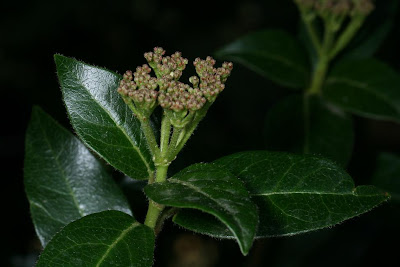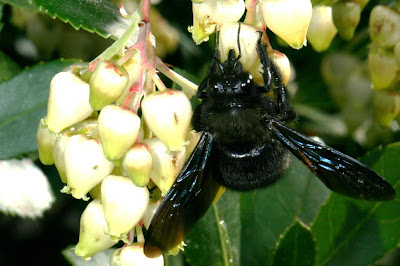perforated prints in the garden Autumn Walking on water ike I change the weather, these days are mixed images with other late summer and autumn pure.
The more rustic lily still show occasional flower and the rare variety of Passionaria, Passiflora sp. that grows in the south wall of the house will, as every year, to be florida to freeze a of these nights.

late
These flowers will come in handy to some bees, wasps and bees primarily to Bombus, are still active sunny days. When I had this plant in the covered terrace is not freezing in winter, but it looked much worse and, while giving many fruits, passion fruits, these were as empty as the few that are growing. Each year he returns to sprout with renewed vigor and bloom for several months until the cold can with it.

But the vine that now shines in all its glory is the ivy , Parthenocisus , which also show the red leaves bore fruit like grapes, as befits a kind of the same family the vines. I have read that some of these grapes can be edible, but given that there are enough species of these vines and are difficult to differentiate, I would not try and also keep away from the Sweet Tooth.

Among the leaves of the vine in the photo are also of ivy, Hedera helix , with its modest flowers. Although there are striking color is visited by bees and wasps and flies especially as this blowfly, Calliphora sp . In all pictures of blow flies that I have is seen as dirty are completely different from the glossy appearance of bees and wasps, although they are feeding on the same flowers. On his chest and abdomen particles are always looking for dandruff.

berries also have the durillo Viburnun tinus, diuretic and laxative properties, but with a degree of toxicity so high it is better not to try to make preparations at home with them difficult to control the dose. It seems they taste so bad that it is not easy to eat for pleasure.

While some plants keep fruits, already seeing the first flower buds, which will take several months to develop and will change color and appearance of the plant, and thus the simplicity of its maintenance the harsh conditions of the center of the peninsula, I think one of the best shrubs that can be put in a hedge.

is something like what happens with the strawberry , Arbutus unedo, the fruits begin to mature while the new flowers emerge. Throughout the year there are many possibilities that a storm or any other cause of damage, so the fruit yield is very variable. I take good years for macerating in anisette liqueur sweet. If the harvest is low to none, not lame anyway always reserve a part for birds, along with other berries that I have scattered throughout the garden showed as last year.

I've also finished the season by collecting, in my own benefit, fruits of the fig, Ficus carica , summer to keep covered with a network. Now let figs retreat available to birds when they begin to need more.

And last for today, but not in the garden, something very special to me, the acorn of Pyrenean oak, Quercus pyrenaica , which this year have produced much fruit. Especially excited because I myself planted acorns from 12 years ago, shortly after moving to this house. And last year gave the odd acorns, but this year are in full production. Also this year have had a couple of Agay species, which is how most of my old oaks, as I feel they are integrated into the ecosystem with their insect parasites and, I suppose, that many more animals that I still have to discover.

and I think my garden is helping to maintain biodiversity and even increase in a rather monotonous meadows and gardens with many native species, including in mine, which also has its concessions to aesthetics.
 had to find the "guilty" of such a crime, so I set out not only to photograph insects coming to the strawberry, but also the way they drink nectar from flowers.
had to find the "guilty" of such a crime, so I set out not only to photograph insects coming to the strawberry, but also the way they drink nectar from flowers.  , however, I could see that their system suck the nectar is getting the peak of the natural opening of the corolla. As you are about to make this honey bee.
, however, I could see that their system suck the nectar is getting the peak of the natural opening of the corolla. As you are about to make this honey bee.  also found a small beetle that came and went through both the natural orifice of the flower as the holes made by the offender unknown.
also found a small beetle that came and went through both the natural orifice of the flower as the holes made by the offender unknown.  I cut a bunch to watch more carefully and I was surprised that many flowers had beetles were inside whole or bitten. Were as suspicious but could not ensure that they were guilty.
I cut a bunch to watch more carefully and I was surprised that many flowers had beetles were inside whole or bitten. Were as suspicious but could not ensure that they were guilty.  were at least two different species and some, I must say that I feel very uneasy. Several species of flies
were at least two different species and some, I must say that I feel very uneasy. Several species of flies  came also strawberry. Especially this great sirphid, almost perfect mimic of bees, which also has a habit of buzzing near my face when moving from flower to an attempt to scare me, I guess. These and other flies
came also strawberry. Especially this great sirphid, almost perfect mimic of bees, which also has a habit of buzzing near my face when moving from flower to an attempt to scare me, I guess. These and other flies  noticed that sometimes took advantage of the holes already made to access the inside of the flower, but never do anything like it try to open the holes themselves.
noticed that sometimes took advantage of the holes already made to access the inside of the flower, but never do anything like it try to open the holes themselves. 

 Finally came two fat bumblebees Xilocopa that much more sparingly than Bombus turned to go quietly flowers, what they were doing? ... they pierce the corolla with great skill to reach the nectar by the shortest route. Here
Finally came two fat bumblebees Xilocopa that much more sparingly than Bombus turned to go quietly flowers, what they were doing? ... they pierce the corolla with great skill to reach the nectar by the shortest route. Here  irrefutable proof.
irrefutable proof.  And here in expanded view, if there were doubts. I could see, and this picture is proof, so get into flowers whose corolla is not yet open, thus anticipating other nectar eaters.
And here in expanded view, if there were doubts. I could see, and this picture is proof, so get into flowers whose corolla is not yet open, thus anticipating other nectar eaters.  Mind you I can not help suspecting, too, of beetles, but I think they are devoted mainly to enlarge the stab wounds that give the dark bees.
Mind you I can not help suspecting, too, of beetles, but I think they are devoted mainly to enlarge the stab wounds that give the dark bees. 




 late
late 








 The bottom photo photographed them in the Manzanares River, a little below the reservoir dam de Santillana and I think they belong to another species of the same family, Aquarius, but I dare not put a species name. There are a couple in intercourse and you can see that the female is full of white eggs which are transparent in the belly distended.
The bottom photo photographed them in the Manzanares River, a little below the reservoir dam de Santillana and I think they belong to another species of the same family, Aquarius, but I dare not put a species name. There are a couple in intercourse and you can see that the female is full of white eggs which are transparent in the belly distended.  also were in a river in the Tea, near Monadriz (Pontevedra), the group photographed the light. They are in the backwaters and are attentive to any vibration telling them that an insect has fallen or is being debated in the water. Among them vehemently disputed the dam and have continued fighting to win over females, but never reached the river of blood.
also were in a river in the Tea, near Monadriz (Pontevedra), the group photographed the light. They are in the backwaters and are attentive to any vibration telling them that an insect has fallen or is being debated in the water. Among them vehemently disputed the dam and have continued fighting to win over females, but never reached the river of blood.  They move breaks the long legs and socks, using the front pair to detect vibrations in the water. They also have a superb view, 360 degrees around, as evidenced by bulging eyes, like balls of pinheads. I spent many hours sitting by the water watching these insects and I have to admit that they've missed the odd bug to see how they hunt. The days when emerging winged ants, many of which fall into the water, becomes an opportunity for the banquet. The third and final
They move breaks the long legs and socks, using the front pair to detect vibrations in the water. They also have a superb view, 360 degrees around, as evidenced by bulging eyes, like balls of pinheads. I spent many hours sitting by the water watching these insects and I have to admit that they've missed the odd bug to see how they hunt. The days when emerging winged ants, many of which fall into the water, becomes an opportunity for the banquet. The third and final  also predator, but feeds on tiny invertebrates, according to its size, which are just below the surface, put the bill under water and suck juices nails it internally. Mosquito larvae, small worms and crustaceans, such as water fleas, are their prey. They can walk the open water, but prefer to do in areas with floating aquatic plants and algae. Are also soaked areas of the shore among mosses and liverworts.
also predator, but feeds on tiny invertebrates, according to its size, which are just below the surface, put the bill under water and suck juices nails it internally. Mosquito larvae, small worms and crustaceans, such as water fleas, are their prey. They can walk the open water, but prefer to do in areas with floating aquatic plants and algae. Are also soaked areas of the shore among mosses and liverworts.